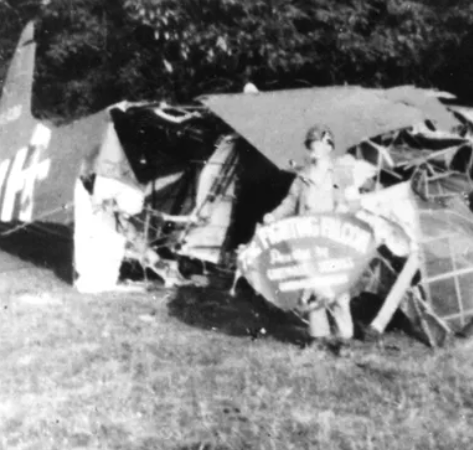EXTREMELY RARE! D-Day “The Fighting Falcon” Painted Plywood Board From Brigadier General Pratt (KIA) CG-4A Waco Glider


















EXTREMELY RARE! D-Day “The Fighting Falcon” Painted Plywood Board From Brigadier General Pratt (KIA) CG-4A Waco Glider
Comes with hand-signed C.O.A.
This is a truly one in a lifetime chance to own a one of one piece from one of the most famous moments and gliders of the D-Day Normandy Invasion.
This extremely rare and museum-grade piece of D-Day history is a large painted wooden plywood board from Brigadier General Pratt’s specially outfitted CG-4A Waco glider famously known as“The Fighting Falcon”. Brigadier General Don Forrester Pratt (KIA June 6, 1944) was the assistant division commander (ADC) of the 101st Airborne Division and was the highest-ranking Allied officer killed on D-Day.
Pratt was a brigadier general on June 6, 1944, the first day of the Allied invasion of Normandy. As deputy commander of the 101st "Screaming Eagles" Airborne Division, Pratt had been scheduled to lead the seaborne element of the division. But Pratt wanted to go into battle as fast as possible, and since he was not qualified to jump by parachute, he sought permission from Gen. Maxwell Taylor, the 101st's commander, to ride in the lead glider.
Piloted by Lieutenant Colonel Mike Murphy, senior glider pilot of IX Troop Carrier Command, and Second Lieutenant John M. Butler, the #1 glider came down into its designated landing zone, LZ "E", two miles west of Sainte-Marie-du-Mont, Manche, Normandy, between 0345 and 0400 hours on June 6, 1944.
Because the one-star general was so important to the invasion plans, steel was welded to the bottom of his plywood glider to prevent bullets and flak from piercing the aircraft.
The Waco glider landed successfully but when Lieutenant Colonel Murphy applied the brakes, the tall wet grass caused the glider to skid without significant slowing, and it overran the landing zone, crashing into a hedgerow line of 40-foot-tall (12 m) poplar trees. Lieutenant Colonel Murphy suffered severe injuries, with both legs broken, one a compound fracture. A tree limb came through the co-pilot side of the cockpit, killing Butler. Pratt, sitting in the Jeep, died from a broken neck resulting from whiplash. The Jeep was not chained, but was tied down with nylon rope and did not break loose. Lieutenant May was riding on the jump seat behind the Jeep and survived the crash.
Pratt's death was portrayed in the film "Saving Private Ryan," though his name was changed to a fictional character, Brig. Gen. Amend.
More Comprenhsive History:
LTC Murphy had instructed his glider pilots to cut off from their tug and land to every cardinal point of the compass in order that they all get onto the ground as quickly as possible. When LTC Murphy cut off, he had an unexpected tail wind up to 27 mph, his compass point was across the short width (approximately 800 feet) of the landing zone and the field was heavy, wet, grass. He dared not change his landing direction because of his orders to his pilots following him to land from all cardinal points of the compass. The result was the glider skidded the width of the field and slammed into the hedge row (tall mound of dirt and trees) moving at 50 mph (Murphy) to 72 mph (Van Gorder) or faster.
With his seat belt fastened, BGen Pratt sitting in his seat in his Jeep, his helmet still strapped to his chin, died of a broken neck resulting from whiplash when the glider hit the hedgerow. This was determined by Capt Charles O. Van Gorder when he checked the body on June 6, 1944 at LTC Murphy’s request and was so stated in his June 6, 1956 letter to LTC Murphy. 1Lt May is said to have been sitting on the folding seat, portside, behind the Jeep and must have braced against the back of the Jeep. 2Lt Butler, flying in the co-pilot seat on the right, died of a head wound and mutilation when the glider nose was destroyed. LTC Murphy, flying in the pilot seat, suffered leg and ankle fractures. Held in by his seat belt, his left leg and upper body went through the fabric on the left side of the cockpit nose and his right leg was in the crumpled mass of steel tubing, wood framework and the BOGN nose protection device that had been in front of him.